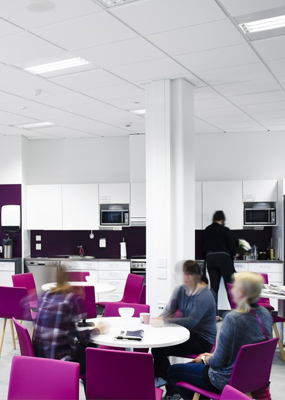
Hiukkavaara School and Community Centre
Project: Hiukkavaara School and Community Centre
Country/city: Finland / Oulu
Architect: Lukkaroinen Architects
Client: Liikelaitos Oulun Tilakeskus
Developer: Lemminkäinen Oy
Photographer: Juha Sarkkinen, Studio Juha Sarkkinen
Production year: Completed summer 2017
Hiukkavaara Community Centre’s defining feature is its versatility. The school building, designed for 700 pupils, houses not only a primary and lower secondary school with 350 pupils, but also a day-care centre and preschool, a youth centre, and a school library. Local residents can make use not only of the spaces, but also of community and adult education activities and sports facilities.
Hiukkavaara Community Centre is used by a highly diverse group of people, meaning that the facilities had to be designed to be as adaptable, multifunctional and comfortable as possible. Particular emphasis was placed on the acoustics of the shared spaces, and the design of the teaching spaces also had to meet the demands the recently reformed Finnish curriculum.
Work on the centre was also guided by objectives relating to sustainability, environmental impact and energy efficiency. The building was soon granted a gold rating under the international green property certification system LEED for Schools.
An inspiring and flexible school that supports the curriculum
Hiukkavaara Community Centre does not contain traditional classrooms, and is instead based around open teaching cells or ‘nests’. The spaces are adaptable and areas can be sectioned off if privacy is required, for example by using curtains and pieces of mobile furniture.
"The largest of these teaching nests can accommodate up to 200 pupils. Currently, our largest teaching group is 130 students – comparable to a relatively small village school. Working in larger groups and in multipurpose spaces require pupils and teachers to be flexible and able to cooperate with one another," explains Director and Head Teacher of Hiukkavaara Community Centre Anne Moilanen.
"These new spaces support the realisation and objectives of the new curriculum – participation, interaction, and building communal knowledge", she states appreciatively.
Listening right from the planning stage
In open learning environments, acoustics require particular attention. An acoustic designer was closely involved in the planning of the project from the very start.
‘Good acoustics improve concentration and increase user satisfaction. Good spatial and interior design allow us to shut out unnecessary distractions and prevent voice problems for the teachers, for example,’ explains Interior Architect Anna Ervasti-Gussander of architecture firm Arkkitehtitoimisto Lukkaroinen, who was responsible for the design of fixed and mobile furnishings at Hiukkavaara, as well as the colour scheme and materials used in the facilities.
Textile carpet was selected as the flooring material for the majority of the open learning environments. The textile carpet also covers part of the partition walls. The acoustically-designed Focus E and conspicious Solo Baffles were were used for the ceiling, whilst Akusto Wall solutions were used on the walls to provide attachment surfaces with acoustic properties.
"The flexibility and versatile nature of the spaces was taken into account in terms of both fixed and mobile furniture. The mobile furniture used is easy to move, and the pieces feature acoustic elements. The centre features a diverse range of teaching cells, which naturally form calmer places to work", states Ervasti-Gussander.
 Multipurpose shared spaces at the centre of the building
Multipurpose shared spaces at the centre of the building
At the heart of the ground floor is a large foyer space, for which the acoustics were a particular area of focus. Ervasti-Gussander regards the acoustic properties of this space as an exceptionally successful element of the project.
The acoustics of the open foyer space and canteen were taken into consideration during the planning stage by opting for sound absorbing rubber tiles as the flooring material. A large proportion of the wall surface is covered with wooden slats, backed with acoustic panels. The ceiling in the foyer and canteen is formed by wood fibre acoustic panels, behind which are sound absorbing panels in places.
The school’s head teacher is also delighted with the acoustics of the space.
"Mealtimes are pleasant, even when there are lots of people and plenty of noise."
Staying overnight at school
Naturally, the users’ needs were also taken into account in the planning of Hiukkavaara: teachers of different subject groups, pupils, and day-care centre staff were all consulted. It is clear to see that the end result has been well received.
"Both employees and pupils are delighted with the new spaces. We’re pleased with both the functionality and the feel of the building. The facilities are so nice that one pupil even wanted to stay at school overnight", states Moilanen.
"For us as spatial designers, Hiukkavaara Community Centre was the first open learning environment we’ve implemented on such a large scale. We are happy with the end result, and the most important thing is that those using the spaces are happy with them too", smiles Ervasti-Gussander.
Text: Eveliina Miettunen
About Hiukkavaara
Awarded LEED Gold for Schools in September 2017
The property covers approximately 11,000 gross m2.
It accommodates a primary and lower secondary school with 350 pupils, six day-care and two preschool groups, a school library, adult education services, sports facilities, and community and youth activity spaces.
The spaces receive around a hundred visitors every evening.
